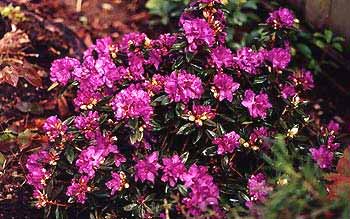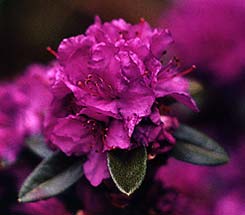
Rhododendron 'Karin Seleger'
a late winter bloomer
"There are fairies at the bottom of our garden."
-Rose Fyleman
(1877‚1957)
(1877‚1957)
The 'Karin Seleger' dwarf rhodie is hybridized from two species. The first is Rhododendron impeditum, a groundcover sometimes called Cloudland Rhododendron, having dense evergreen foliage & purple blooms in April & May. It was collected during an alpine trek in 1911 n Yunnan, China, by Scottish plant hunter George Forrest, who brought it to the Royal Botanic Garden in Edinburgh, & its cultivar history begins there.
It was crossed with R. dauricum, a native of the Altai Mountains in Russia east through frigid Siberia, Northern Manchuria & China. Being a subarctic plant, when grown in temperate regions it blooms before the end of winter. It has been in cultivation since 1780. It is deciduous, & even though an evergreen variety entered cultivation in 1817, 'Karin Seleger's' pedigree is with the deciduous form, which has frequently been crossed with evergreen rhodies to develop cold-hardiness in shrubs that do not lose their leaves in winter.
 These two dwarf rhododendrons were hybridized by famed alpine gardener Barrie Porteous of Muskoka, Canada. R. impeditum x. dauricum preserves the best traits of the R. dauricum in that it begins blooming just before Spring in early to mid March, insuring that the rhododendrons' flower season starts early. And it adds to these fine traits R. impeditum's evergreen alpine hardiness.
These two dwarf rhododendrons were hybridized by famed alpine gardener Barrie Porteous of Muskoka, Canada. R. impeditum x. dauricum preserves the best traits of the R. dauricum in that it begins blooming just before Spring in early to mid March, insuring that the rhododendrons' flower season starts early. And it adds to these fine traits R. impeditum's evergreen alpine hardiness.The flower on this hybrid combination came out a flourescent violet purple, not large but thickly covering the shrub. It provides a startling mound of purple.
Its chief fault is the way the flowers "stick" to the plant after they are dying & brown. There are way too many blooms to hand-remove, so the shrub will look pretty awful for a little while before reverting to its post-flowering compact leafy beauty, which can take until the third week of April. So while its blooms are long-lasting, they are only perfect in March. And I must admit I do fault the shrub because of this, when comparing it to, say, the 'PJM Elite' which drops its spent petals very tidily on its own.
To cope with its "flaws" of excessive bloom that wear out in homely patches, I moved the shrub to a location where it would get more sun. It was previously overshadowed by the Cedar of Lebanon & a huge Whitethroat Azalea. It didn't complain of its lack of sunlight so far as blooming was concerned, but this hubrid does generally like more sun, & it was my suspicion that when the blooms are spent, they might be more inclined to drop from the limbs if they could dry better in sun. So it was moved, & was keeping the company of the Loder's White.
When it was moved, I gave it as big a feeding as was likely to be safe. Early indication was that my plan to force it to put on a lot of new growth was working. If a newly transplanted rhody expends energy spring through autumn on new leafage, it will probably not be quite as thickly flowered the next year. And for this one it could simply be improved by showing more of its leaves while in bloom.
I expected to find out the following year if this technique improved its look for my tastes. Obviously for most rhodies it would be improper to force a lot of growth out of it right away, as it is better to pinch off new growth so that it will use more of its first-year energy extending roots, & it's rare anyone would want such a shrub to flower less. But in this case I would like to see more of the shrub's overall structure rather than just a heap of blooms.
Unfortunately, the summer after the transplant, there was a drought, & I had not noticed the soaker hose really wasn't keeping the root of 'Karin Seliger' moist. The shrub burnt right up in a record heat, which it might not have done but for being so recently transplanted. I kept it in the ground until the following year hoping it would show some new growth somewhere on the dead branches, & then I could clip away all that was not alive & let it start over. Alas, it had truly died. I ended up putting in its place a species rhody, R. racemosum, an upright skinny shrub I immediately liked a thousand times better.
I had to wonder in passing about how it was that a little shrub I hadn't liked all that much would be one of our few shrubs ever to kick the bucket. Did I subconsciously let it miss getting watered by the soaker hose? I don't really think so, as I was much more heartsick to lose a species shrub during the same heatwave (namely R. telmateium), & many things were so stressed in that record-hot summer that they bloomed poorly the following spring.
Still, one is almost tempted to believe the silly stories about Telepathic Plants, & 'Karin Seliger' commited suicide because it was insufficiently liked. The sorry thing is, if I hadn't transplanted it, it would've continued to be fine in the shadier location where it was originally planted.
Had it not gone to Plant Heaven without me, I could have expected it to remain a slow grower to thirty-inches, with a potential three foot spread. 'Karin Seleger' will do well in partial shade, better still with sun, & loves moist acidic soil & mild summers. As I found out, it hates insufficiently moist soil & record-hot summers. As to winter, it will thrive to minus 15 Fahrenheit, as its family tree prepared it for nasty cold weather.
If we had limitless room, I might be tempted to replace 'Karin Seleger' & make sure it never went dry or overheated. Though it was never a favorite, it did insure that the rhododendron season started in March. However, we've other rhododendrons I like better that bloom just as early, plus my fondness for dwarf species rhododenrons has meant that most spots that might've gone to little hybrids have had the space devoted to species shrubs instead.